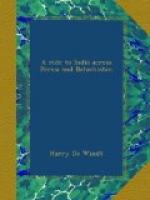Kazvin, which now has a population of 30,000, has seen better days. It was once capital of Persia, with 120,000 inhabitants. Strolling out in the morning before breakfast, I found it well and regularly built, and surrounded by a mud wall, with several gates of beautiful mosaic, now much chipped and defaced.
Being the junction of the roads from Tabriz on the west, and Resht on the north to the capital, is now Kazvin’s sole importance. The road to Teheran was made some years ago at enormous expense by the Shah; but it has now, in true Persian style, been left to fall into decay. It is only in the finest and driest weather that the journey can be made on wheels, and this was naturally out of the question for us. A railway was mooted some time since along this, the only respectable carriage-road in Persia—but the project was soon abandoned.
The post-houses, however, are a great improvement on any in other parts of the country. At Kishlak, for instance, we found a substantial brick building with a large guest-room, down the centre of which ran a long table with spotless table-cloth, spread out with plates of biscuits, apples, nuts, pears, dried fruits, and sweetmeats, beautifully decorated with gold and silver paper, and at intervals decanters of water—rather cold fare with the thermometer at a few degrees above zero. The fruits and biscuits were shrivelled and tasteless, having evidently been there some months. It reminded me of a children’s doll dinner-party. With the exception of these Barmecide feasts and some straw-flavoured eggs, there was nothing substantial to be got in any of the post-houses till we reached our destination.
About four o’clock on the 27th we first sighted the white peak of Mount Demavend, and by three o’clock next day were within sight of the dingy brown walls, mud houses, and white minarets of the city of the Shah—Teheran.
[Footnote A: Both have since met violent deaths. Captain Gill was murdered by natives with Professor Palmer near Suez, and Captain Clayton killed while playing polo in India.]
CHAPTER V.
TEHERAN.
A brilliant ball-room, pretty faces, smart gowns, good music, and an excellent supper;—thus surrounded, I pass my first evening in Teheran, a pleasant contrast indeed to the preceding night of dirt, cold, and hunger.
But it was not without serious misgivings that I accepted the courteous invitation of the German Embassy. The crossing of the Kharzan had not improved the appearance of dress-clothes and shirts, to say nothing of my eyes being in the condition described by pugilists as “bunged up,” my face of the hue of a boiled lobster, the effects of sun and snow.
One is struck, on entering Teheran, with the apparent cleanliness of the place as compared with other Oriental towns. The absence of heaps of refuse, cess-pools, open drains, and bad smells is remarkable to one accustomed to Eastern cities; but this was perhaps, at the time of my visit, due to the pure rarified atmosphere, the keen frosty air, of winter. Teheran in January, with its cold bracing climate, and Teheran in June, with the thermometer above ninety in the shade, are two very different things; and the town is so unhealthy in summer, that all Europeans who can afford to do so live on the hills around the capital.




